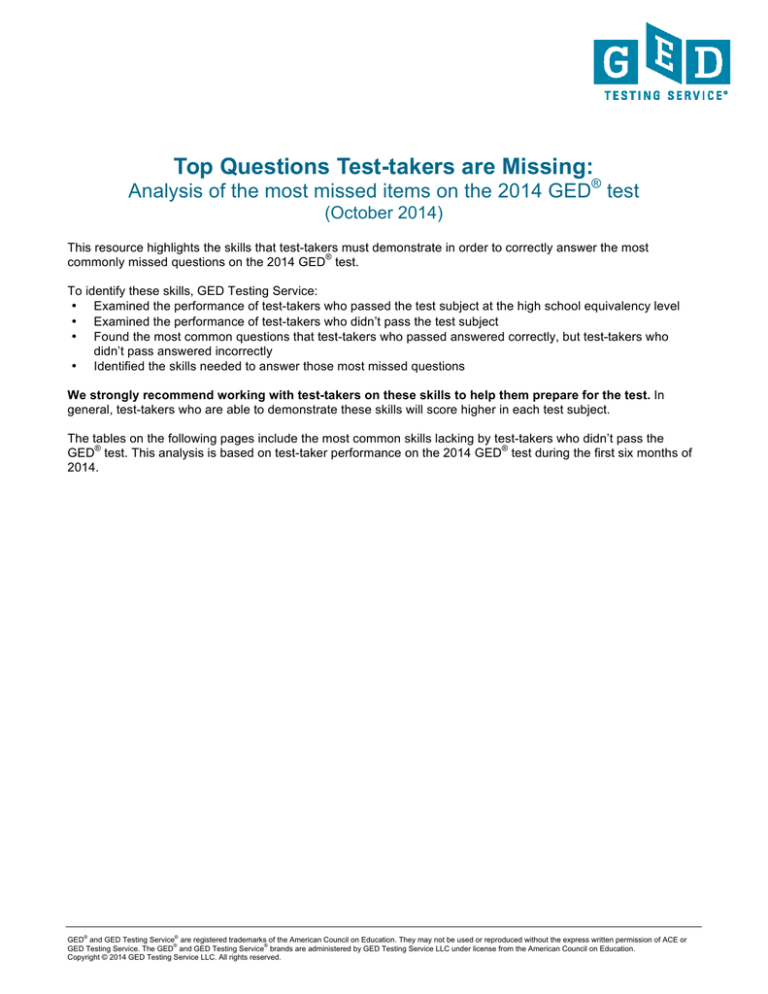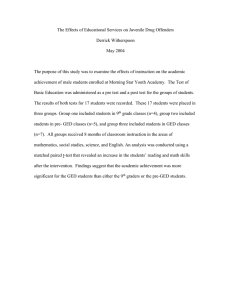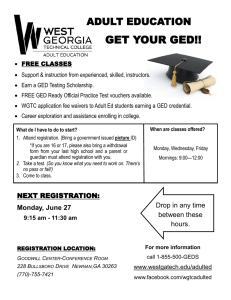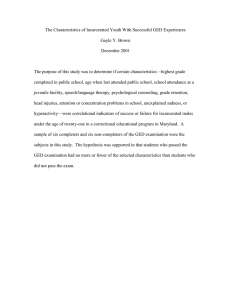
Top Questions Test-takers are Missing:
Analysis of the most missed items on the 2014 GED® test
(October 2014)
This resource highlights the skills that test-takers must demonstrate in order to correctly answer the most
®
commonly missed questions on the 2014 GED test.
To identify these skills, GED Testing Service:
• Examined the performance of test-takers who passed the test subject at the high school equivalency level
• Examined the performance of test-takers who didn’t pass the test subject
• Found the most common questions that test-takers who passed answered correctly, but test-takers who
didn’t pass answered incorrectly
• Identified the skills needed to answer those most missed questions
We strongly recommend working with test-takers on these skills to help them prepare for the test. In
general, test-takers who are able to demonstrate these skills will score higher in each test subject.
The tables on the following pages include the most common skills lacking by test-takers who didn’t pass the
®
®
GED test. This analysis is based on test-taker performance on the 2014 GED test during the first six months of
2014.
®
®
GED and GED Testing Service are registered trademarks of the American Council on Education. They may not be used or reproduced without the express written permission of ACE or
®
®
GED Testing Service. The GED and GED Testing Service brands are administered by GED Testing Service LLC under license from the American Council on Education.
Copyright © 2014 GED Testing Service LLC. All rights reserved.
Reasoning Through Language Arts
Indicator
*
Code
R.2.1
*
Skill Overview
Understand specific details and
main ideas in a written source,
at a limited and/or inconsistent
level
Description
Given text, students should be
able to
• determine the central ideas
or themes of the text
• analyze the development of
these ideas and/or themes,
and
• summarize the key details
and ideas that support the
main themes.
R.2.5
Determine which details support
the main idea
R.2.6
Identify a theme or element of a
written source that supports a
theme
Given text, students should be
able to
• identify the detail or details
that support a particular
main idea.
Given a main idea and several
details, test-takers should be
able to
• identify which detail (s)
support the main idea, and
which do not.
Given text and a number of
possible themes that could
describe that text, students
should be able to
• correctly identify the theme
and
• identify elements of the text
(such as plot, characters,
setting, dialog, etc.) that
support a particular theme.
R.3.3
Analyze relationships within
written sources
Example or
Additional Details
The details referred to here are
ones that are explicitly stated in
the text: this indicator does not
require the student to make
inferences.
This indicator applies to literary
texts only.
Given a literary or informational
passage, students should be
able to
• analyze and describe the
relationship between two
things -- e.g., two
characters, two events, a
character and an event,
two ideas, etc.).
“Indicator Code” refers to the GED® test indicator numbering in Chapter 2 of the Assessment Guide for Educators.
GEDtestingservice.com • GED.com
2
Science
Indicator
Code*
SC.3.a
SC.6.c
SC.7.a
Skill Overview
Pull specific evidence from a
written source to support a
finding or conclusion.
Description
Given a passage that presents
a description of an experiment
or a summary of findings of an
investigation, students should
be able to
• identify and cite evidence
from the passage that
supports the finding or
conclusion.
Express scientific information or
findings in words.
When provided with scientific
information in one form,
students should be able to
"translate" that information into
another form.
Understand and apply scientific
models, theories, and
processes.
GEDtestingservice.com • GED.com
When provided with
background information on
common biological, chemical,
or physical processes, students
should be able to
• complete the description by
providing any missing
information or to identify
relationships among
concepts that are described
in the background
passage..
Example or
Additional Details
Evidence could consist of a
variety of elements, including
data, quotations from experts,
illustrative examples, etc.
Evidence is something that
tends to prove or disprove
something -- it is different from
details or reasoning.
This particular practice focuses
on information that is presented
numerically (e.g., in a table) or
visually (e.g., in some graphical
format) into words and
sentences.
Examples might be to explain in
words a relationship that is
expressed graphically or in a
scientific equation.
Examples of the foundational
models and theories would
include things like Newton's
laws of motion, the law of
conservation of energy, the
structure of DNA, the origin of
the universe (the "Big Bang"),
the structure of the earth, plate
tectonics, particle-wave theory,
etc. These theories are "big
ideas" in science rather than
specialized or esoteric
principles or processes.
Students who possess some
background knowledge in these
areas will be best able to attain
the highest score points on this
indicator.
3
Social Studies
Indicator
Code*
SSP.1.a
Skill Overview
Determine the clearly stated
details in primary and
secondary sources, and use
this information to make logical
inferences or valid claims at a
limited and/or inconsistent
level.
SSP.2.b
Describe people, places,
environments, processes, and
events, and the connections
between and among them.
SSp.3.c
Analyze cause-and-effect
relationships, including those
with multiple factors.
GEDtestingservice.com • GED.com
Description
Given a stimulus passage,
students should be able to
• make inferences that are
not explicitly stated but that
are supported logically by
the details that are
explicitly stated in the
passage.
Given a stimulus passage,
students should be able to
• express how two or more
of the elements listed are
related.
Given a descriptive stimulus
passage, students should be
able to
• demonstrate understanding
of a cause-and-effect
relationship by explaining
how or why one thing
cased something else.
Example or
Additional Details
Examples of the relationship
might be categorization,
similarities or differences, how
one element represents a part
of the other, etc.
4
Mathematical Reasoning
Quantitative Reasoning
Indicator
Code*
Q.4.b
Q.4.c
Q.4.d
Skill Overview
Compute the area and
circumference of circles. Find
the radius or diameter of a
circle when given the area or
circumference.
Compute the perimeter and
area of polygons. Find side
lengths of a polygon when
given the perimeter or area.
Compute the perimeter and
area of two-dimensional
composite shapes, which could
include circles.
Description
N/A
N/A
N/A
Example or
Sample Lesson Plan
The area of a circle is 855
square inches. What is the
diameter of the circle?
Find the (a) height and (b)
perimeter of an isosceles
triangle whose area is 12
square feet and whose base is
6 feet.
Find the area and perimeter of
the following figure:
3’
3’
Q.3.b
Use scale factors to determine
the magnitude of a size
change. Convert between
actual drawings and scale
drawings.
N/A
Two rectangles are similar
figures. The area of one of the
rectangles is 24 square inches
and one side is 8 inches. The
other rectangle has one side
that measures 12 inches.
What is the area of the second
rectangle?
What is the scale factor
between the first and second
rectangles?
Q.3.d
Solve two-step, arithmetic, real
world problems involving
percents.
GEDtestingservice.com • GED.com
Examples include but are not
limited to: simple interest, tax,
markups and markdowns,
gratuities and commissions,
percent increase and decrease.
In June Sam worked 45.5
hours and in July he worked 35
hours. What is the percentage
decrease in his hours from
June to July, to the nearest
percent?
5
Algebraic Reasoning
Indicator
Code*
A.5.a
A.5.b
A.5.d
Skill Overview
Locate points in the coordinate
plane.
Determine the slope of a line
from a graph, equation, or
table.
Graph two-variable linear
equations.
Description
N/A
N/A
N/A
Example or
Sample Lesson Plan
Locate the point (-3, 4)
What is the slope of the line
represented by the equation y
= -5x + 2?
What is the slope of the line
that passes through the points
(-4, 3) and (2, -1)?
Graph the line for the equation
Y = 2x – 1.
(complete a table with values
for X and Y)
GEDtestingservice.com • GED.com
6
Mathematical Practice and Content Interaction (search for and recognize entry points for solving a
problem) and Algebraic Reasoning
Indicator
Code*
A.2.a
Skill Overview
Solve one-variable linear
equations, and formulas with
multiple variables.
Description
Given a one-variable linear
equation or a formula with
multiple variables, the student
should be able to
• identify or create the first
step of a solution process.
With this particular indicator,
students do not have to present
or formulate a complete
solution -- they simply need to
be able to identify or create a
first plausible step in the
process.
Example or
Additional Details
In the equation below,
-2(x – 7) = 8x + 3 – 6x
Which of the following could be
a first step in solving the
equation?
A.
B.
C.
D.
A.3.a
A.4.a
Solve linear inequalities in one
variable.
Solve one-variable quadratic
equations with real solutions,
using any appropriate method.
Given linear inequalities in one
variable, the student should be
able to identify or create the
first step of a solution process.
Given one-variable quadratic
equations with real-number
solutions, the student should
be able to identify or create the
first step of a solution process.
Add 7 to both sides of the
equation
Subtract x from both sides
of the equation
Combine all of the terms
on the right-hand side of
the equation
Apply the distributive
property to the left-hand
side of the equation [key]
With this particular indicator,
students do not have to present
or formulate a complete
solution -- they simply need to
be able to identify or create a
first plausible step in the
process.
Given the inequality 2 < x < 8,
what is a first step you could
take to determine the values for
x?
With this particular indicator,
students do not have to present
or formulate a complete
solution -- they simply need to
be able to identify or create a
first plausible step in the
process.
Given the equation
2
4x + 3x – 27 = 0, what is a first
step you could take to solve for
x?
GEDtestingservice.com • GED.com
7
Mathematical Practice and Content Interaction (create algebraic models that represent real-world
situations) and Algebraic Reasoning
Indicator
Code*
A.1.c
Example or
Additional Details
Example: On a field trip, there
must be 1 chaperone for every
6 students. What expression
could be used to represent the
number of chaperones
required?
A 6s
B s/6 [key]
C 6c
D c/6
Skill Overview
Create linear expressions as
part of word-to-symbol
translations or to represent
situations you have been given.
Description
Given a real-world situation,
the student should be able to
translate the situation in words
into a linear expression
A.2.c
Create one- or two-variable
linear equations to represent
situations you have been given.
Given a real-world situation,
the student should be able to
create one- or two-variable
linear equations that represent
the situation
Example: On a field trip, there
must be 1 chaperone for every
6 students. Additionally, 1 extra
chaperone is required as a
floater. Which equation can be
used to find the number of
chaperones, c, that is required
for s students?
A c = 6s + 1
B* c = s/6 + 1
C s = 6c + 1
D s = c/6 + 1
A.3.d
Create one-variable linear
inequalities to represent
situations you have been given.
Given a real-world situation,
the student should be able to
create a one-variable linear
inequality that represents the
equation
Example: Keith has $500 in a
savings account at the
beginning of the summer. He
wants to have at least $200 in
the account by the end of the
summer. He withdraws $25
each week for food, clothes,
and movie tickets. What
inequality represents this
situation?
Key: 500 - 25w >= 200
GEDtestingservice.com • GED.com
8



